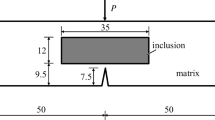Conclusions
The residual thermal stresses in the constituents of a fiber-reinforced epoxy have been predicted using a concentric three-cylindrical (fiber-interphase-matrix) assemblage analysis. The interphase has been treated as a region with a variable Young's modulus — a direct consequence of the changes in the microstructure of the matrix near the fiber surface. The Navier equations of elasticity have been solved in series form solutions for each type of property variation.
A parametric study is used to demonstrate the fact that changes in the interphase properties can drastically affect the residual stresses in the interphase.
Similar content being viewed by others
References
K. L. Powell, P. A. Smith, and J. A. Yeomans, “Aspects of residual thermal stresses in continuous-fiber reinforced ceramic matrix composites,” Composite Sci. & Technol.,47, 359–367 (1993).
W. B. Avery and C. T. Herakovich, “Effect of fiber anisotropy on thermal stresses in fibrous composites,” ASME J. of Appl. Mech.,53, 751–756 (1986).
I. Jasiuk and M. W. Kouider, “The effect of an inhomogeneous interphase on the elastic constants of transversely isotropic composites,” Mech. Materials.,15, 53–63 (1993).
G. C. Papanicolaou, G. J. Messinis, and S. S. Karakatsanidis, “The effect of interfacial conditions on the elastic, longitudinal modulus of fiber reinforced composites,” J. Materials Sci.,24, 395–401 (1989).
Y. Mikata and M. Taya, “Stress field in a coated continuous fiber composite subjected to thermo-mechanical loadings,” J. Composites Materials,19, 554–571 (1985).
C. M. Warwick and T. W. Clyne, “Development of composite coaxial stress analysis model and its application to SiC monofilament systems,” J. Materials Sci.,26, 3817–3827 (1991).
S. D. Gardner, C. U. Pittman Jr., and R. M. Hackett, “Residual thermal stresses in filamentary polymer-matrix composites containing an elastomeric interphase,” J. Composites Materials,27, 830–860 (1993).
K. Jayaraman and K. L. Reifsnider, “The interphase in unidirectional fiber-reinforced epoxies: Effect of residual thermal stresses,” Composites Sci. & Technol.,47, 119–129 (1993).
K. Jayaraman and K. L. Reifsnider, “Residual stresses in a composite with continuously varying Young's modulus in the fiber/matrix interphase,” J. Composite Materials.,26, 770–791 (1992).
N. R. Sottos, R. L. McCullough, and S. I. Guceri, “Thermal stresses due to property gradients at the fiber/matrix interface,” Proc. of the 3rd Joint ASCE/ASME Mechanics Conf. (1989), pp. 11–20.
D. Kouris and E. Tsuchida, “On the elastic interaction between two fibers in a continuous fiber composite under composite under thermal loading,” Mech. Materials,12, 131–146 (1991).
O. C. Zienkiewicz, “The finite element method” (3rd ed.) McGrawHill, London (1977).
D. F. Adams, “A micromechanical analysis of the influence of the interface on the performance of polymers matrix composites,” Proc. of the American Soc. for Composites. 1st Techn. Conf., Oct. 7–9, (1986) Dayton, Ohio.
V. Nassehi, J. Dhillon, and L. Mascia, “Finite element simulation of the micromechanics of interlayered polymer/fiber composites: A study of the interactions between the reinforcing phases,” Composites Sci. & Technol.,47, 349–358 (1993).
R. P. Nimmer, R. J. Bankert, E. S. Russell, G. A. Smith, and P. K. Wright, “Micromechanical modelling of fiber/matrix interface effects in transversely loaded ScI/Ti-6-4 metal matrix composites,” J. Composite Technol. & Research,13, No. 1, 3–13 (1991).
B. F. Sorensen and R. Talreja, “Effects of nonuniformity of fiber distribution on thermally-induced residual stresses and cracking in ceramic matrix composites,” Mech. Materials.16, 351–363 (1993).
A. Plepys, M. S. Vratsanos, and J. R. Farris, “Determination of residual stresses using incremental linear elasticity,” Composite Struct.,27, 51–56 (1994).
J. A. Nairn, and P. Zoller, “Matrix solidification and the resulting residual thermal stresses in composites,” J. Materials Sci.,20, 355–367 (1985).
N. J. Pagano and G. P. Tando, “Composite Sci. & Technol.”31, 273–292 (1988).
Author information
Authors and Affiliations
Additional information
Published in Mekhanika Kompozitnykh Materialov, Vol. 30, No. 5, pp. 579–589, September–October, 1994.
Rights and permissions
About this article
Cite this article
Kushnevsky, V., Wacker, G., Chate, A. et al. The effect of interphase on residual thermal stresses. 1. Single fiber composite materials. Mech Compos Mater 30, 417–425 (1995). https://doi.org/10.1007/BF00616769
Received:
Issue Date:
DOI: https://doi.org/10.1007/BF00616769




